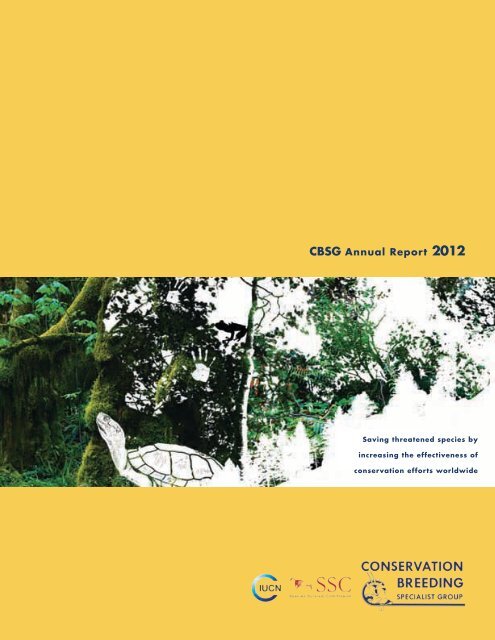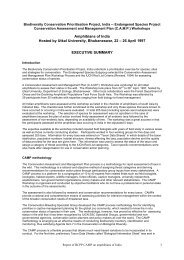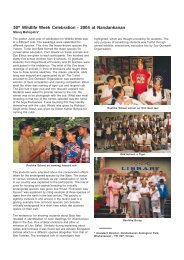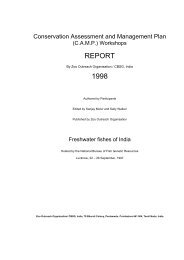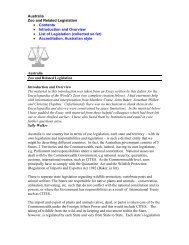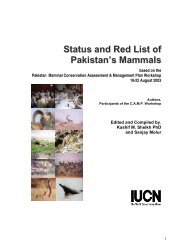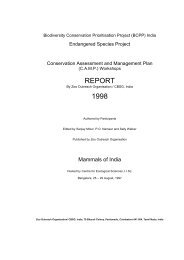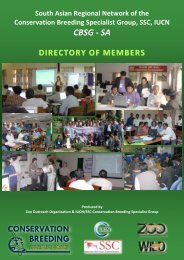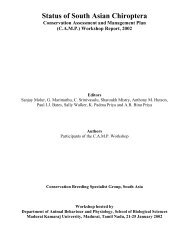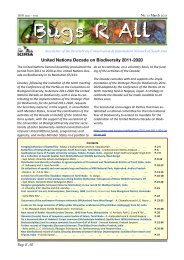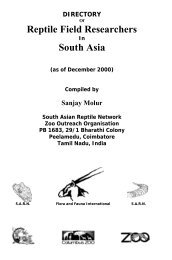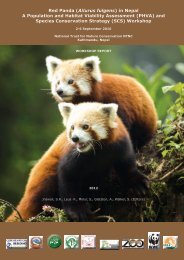CBSG Annual Report 2012 - Zoo Outreach Organisation
CBSG Annual Report 2012 - Zoo Outreach Organisation
CBSG Annual Report 2012 - Zoo Outreach Organisation
You also want an ePaper? Increase the reach of your titles
YUMPU automatically turns print PDFs into web optimized ePapers that Google loves.
<strong>CBSG</strong> <strong>Annual</strong> <strong>Report</strong> <strong>2012</strong>Saving threatened species byincreasing the effectiveness ofconservation efforts worldwide
CONTENTSFrom the Chair 2What We Do 3Success StoriesConfronting a New Threat to Western Pond Turtles 4Promoting Wattled Crane Conservation in South Africa 5Modeling Interactions between Threatened and Invasive Species 6Collaborating for Conservation in Djibouti 7Exploring Strategies to Save Eastern Barred Bandicoots 8Identifying Actions for River Turtle Conservation 9New InitiativesAddressing Climate Change Head On 10Measuring the Impact of Human Behavior on Conservation Efforts 12<strong>CBSG</strong> Conservation Activities in <strong>2012</strong>PHVA and Species Conservation PlanningWorkshops / Sponsors 14Training Workshops / Sponsors 15Tool Development Workshops / Sponsors 16Planning Workshops for ConservationOrganizations / Sponsors 16Sponsors of <strong>CBSG</strong> Conference Participation 17About <strong>CBSG</strong> 18<strong>2012</strong> Ulysses S. Seal Award 19<strong>CBSG</strong> Donors 20GCN Financial Board and <strong>CBSG</strong> Advisory Committee 21<strong>2012</strong> Strategic Committee 22<strong>2012</strong> Financial Information 23<strong>CBSG</strong> Staff and Regional Networks 24
CONSERVATION BREEDING SPECIALIST GROUP <strong>2012</strong>FROM THE CHAIRThis past year marked the end of the IUCN Species Survival Commission’s (SSC) 2009-<strong>2012</strong>quadrennium. As a Specialist Group within the SSC, <strong>CBSG</strong> was privileged to be a part of a numberof inspiring quadrennial events. A highlight was the World Conservation Congress in Jeju, SouthKorea, where Simon Stuart was re-elected to lead the SSC and where the Species Strategic Plan wasadopted. This plan maps the SSC’s role in achieving the globally recognized Aichi Targets, set in 2010at the Convention on Biodiversity conference, and will guide <strong>CBSG</strong>’s work for the next four years.The next two quadrennia will be defining for us, as they align with the eight years remaining in theDecade of Biodiversity—the time set for achieving the Aichi targets. There are several targets to which<strong>CBSG</strong> is committed to contributing, but none is as central to our mission as Target 12: By 2020 theextinction of known threatened species has been prevented and their conservation status, particularlyof those most in decline, has been improved and sustained. The work described in this <strong>Annual</strong> <strong>Report</strong>illustrates this commitment.One example is <strong>CBSG</strong>’s One Plan approach to species conservation planning: the development ofmanagement strategies and conservation actions by all responsible parties for all populations of aspecies, whether inside or outside their natural range. We are actively promoting this approach so thatresulting integrated conservation plans benefit from the full suite of tools available to ensure the future ofthreatened species in the wild.Activities that exemplify<strong>CBSG</strong>’s One Plan approachare identified with this graphic.Target 12 cannot be achieved unless the grave threat of climate change is urgently addressed. Climate change is undermining our conservation effortsas well as putting species not previously considered threatened at risk of extinction. <strong>Report</strong>s from the Intergovernmental Panel on Climate Change and arecently published paper by Foden et al. confirm this and acknowledge that reducing greenhouse emissions will reduce climate change-driven extinctions.<strong>CBSG</strong> has responded to this crisis with an initiative (see p.10-11) to engage the zoo and aquarium community in sending a strong message to the world’sleaders to enact policy to get and keep atmospheric levels of CO 2back to a “safe” 350 ppm. One powerful component to this movement is divestmentfrom fossil fuel companies. Specifically, we are asking zoos and aquariums to move money that is currently invested in the fossil fuel industry and reinvestit in companies that reflect their conservation mission. <strong>CBSG</strong> has committed to divesting the reserve funds of our non-profit support entity, the GlobalConservation Network, and we encourage zoos and aquariums worldwide to participate in the movement by joining us in this and a variety of othermeaningful activities.It’s clear that we are facing daunting challenges. The SSC’s Strategic Plan and the Aichi Targets provide us a broad framework for action. <strong>CBSG</strong>’sresponsibility is to remain focused on our mission of species conservation while reflecting the sense of urgency these challenges demand. I believe that asindividuals our task is the same: to dedicate ourselves to doing what we can to ensure a livable future for all the species that share this planet. And, as BillMcKibben, founder of 350.org, says, what could be more rewarding than knowing that you are doing every day the most important work there is to do?Thank you for your continued commitment to <strong>CBSG</strong> and to the future of our planet and all the species with which we share it.Dr. Onnie Byers, Chair2
Conservation Breeding Specialist group <strong>2012</strong>Confronting a New Threat to Western Pond TurtlesWestern Pond Turtle Facts• Turtle hatchlings leave the nest when they are about 20-25mm long,leaving them prone to predation.• A head-start program keeps young pond turtles in controlledconditions until they are large enough to avoid predation. Whilethis process may take two to three years in the wild, growth is muchfaster in the captive environment.• Western pond turtles are long lived (40+ years) and reproduce slowly.Losing an adult means a loss of as many as 30 years of hatchlingproduction.“With today’s significant financial and time constraints on staff, the PHVA provided an especially efficient method for reaching consensuson prioritized, needed strategic actions.” —Fred Koontz, Seattle’s Woodland Park <strong>Zoo</strong>The SituationHabitat fragmentation and voracious predation by invasive bullfrogs havedramatically reduced the abundance of western pond turtles (Actinemysmarmorata) throughout their range from Washington’s Puget Sound tothe northern reaches of the Baja California peninsula. For more than 20years, local zoos have implemented a head-start program in which wildturtle eggs are brought into controlled conditions and the hatchlings arereared over winter. They are returned to the wild when they are largeenough to escape hungry bullfrogs. More recently, a new danger hasemerged in both wild and zoo environments: a potentially fatal diseasethat damages the shell of adult turtles.The ProcessAt the invitation of the Recovery Team coordinating conservation activitiesin Washington, <strong>CBSG</strong> facilitated a PHVA workshop for the state’s westernpond turtle population. Key objectives for the workshop included anevaluation of the current status of both the species and the conservationprogram, as well as a clarification of the state Recovery Team’s futureresearch and management agenda. Workshop participants created adetailed “threat map” of the diverse biological and institutional challengesto species conservation. Analysis of detailed demographic simulationmodels via a population viability analysis (PVA) revealed the criticalimportance of adult survivorship to long-term species viability.The ResultsA number of key management actions were identified and prioritizedthrough the PHVA process. The results of the population viability simulationmodeling reinforced the importance of mitigating the threat of hatchlingpredation by invasive bullfrogs. Moreover, the PVA results emphasizingthe importance of adult survivorship stimulated the group to begin urgentlycoordinating a research program to evaluate the epidemiology, prevalence,and impacts of the emerging ulcerative shell disease. The workshopdiscussion highlighted the need for improved information sharing amongstakeholders, resulting in the formation of a set of thematic subgroups toaddress research questions and management recommendations.4
Success storiesPromoting Wattled Crane Conservation in South AfricaWattled Crane Facts• Wattled cranes are principally threatened by loss and degradationof their wetland habitat due to agriculture, industrialization, andovergrazing by domestic animals.• Though most wattled crane pairs lay only a single egg, sometimesfemales lay a second egg, which is subsequently abandoned.• An annual aerial survey monitors all wattled crane nests in SouthAfrica and identifies pairs that have laid two eggs. Second eggs fromthese nests may be candidates for raising in captivity.• Conservation translocations of wattled cranes are planned to begin in2014/15 to reinforce the wild population.“The ongoing support and expertise of <strong>CBSG</strong> has been invaluable in moving wattled crane conservation forward in South Africa, fromorganizing the original PHVA 13 years ago right through to the development of the PAAZAB APP earlier this year.” —Stephen van derSpuy, African Association of <strong>Zoo</strong>s and Aquaria (PAAZAB)The SituationThe wattled crane (Bugeranus carunculatus) is an IUCN globally Vulnerablespecies with a rapidly declining population. In South Africa, the species isconsidered nationally Critically Endangered, having undergone dramaticdeclines in both numbers and range. Isolated from larger populations furthernorth in Africa, the South African population currently consists of about260 birds restricted mainly to the province of KwaZulu Natal. This longlivedand slow-breeding species has suffered extensively from loss of keywetland nesting habitat, poisoning, and power line collisions. <strong>CBSG</strong> hassupported wattled crane conservation since our first involvement in 2000by conducting a PHVA workshop for wattled cranes in South Africa.The ResultsSince the PHVA, the WCRP has steadily built an ex situ population of wattledcranes by harvesting, incubating, and rearing “doomed” second eggsfrom wild nests (which only fledge a single chick) to provide birds for theconservation breeding program. This captive flock, now numbering 44 birds,is managed by the PAAZAB APP and is designed as a source populationfor releases into the wild. In 2013, the WCRP defined the goals of thereinforcement program for the KwaZulu Natal wattled crane population.These specific goals will help direct further actions as part of an integratedOne Plan approach to conservation planning for this species.The ProcessThe 2000 PHVA resulted in the formation of the Wattled Crane RecoveryProgramme (WCRP), a coalition of five partners from the in situ and ex situcommunities dedicated to conserving this species in South Africa. WCRPpartners include Ezemvelo KwaZulu Natal (eKZN) Wildlife, EndangeredWildlife Trust, Johannesburg City Parks and <strong>Zoo</strong>, the African Association of<strong>Zoo</strong>s and Aquaria (PAAZAB), and eKZN Crane Foundation. Considerableconservation progress led to a PHVA review in 2009 and a WCRP meetingin <strong>2012</strong> to document progress and focus on future priorities, includingtranslocation techniques. <strong>CBSG</strong> Southern Africa continues to support the workof the WCRP and of the PAAZAB conservation breeding program (APP).5
Conservation Breeding Specialist group <strong>2012</strong>Modeling Interactions between Threatened and Invasive SpeciesBlackbird and Cowbird Facts• Yellow-shouldered blackbirds are threatened by the invasive shinycowbird, along with other invasive species such as rats, mongoose,domestic cats, and possibly green iguanas, boas, and rhesus monkeys.• The shiny cowbird is an obligate nest parasite, targeting morethan 200 host species throughout its range. These birds lower thereproductive output of their host by egg stealing and egg puncturing.• Over 200 artificial nest structures have been placed in blackbirdmangrove habitat. Nests are monitored during breeding season andany invasive cowbird eggs are removed.• Blackbirds lay bluish eggs (about three per clutch), while shiny cowbirdeggs are speckled brown.“The PHVA workshop was very successful in bringing together experts in the field to review the past and present of the species involved,allowing the scientists to visualize the different types of management techniques and their interactions, and facilitating the determination ofthe best strategies to continue recovery of this species.” —Ricardo Lopez Ortiz, Puerto Rico Department of Natural ResourcesThe SituationThe picturesque island of Puerto Rico is home to the endemic yellowshoulderedblackbird, once considered common in both the mountainousinterior and low-lying coastal areas. Since the 1940s, however, thespecies has declined in abundance by more than 80% and is mostlyrestricted to coastal mangrove habitat in the southwestern corner of theisland. A major factor in this decline was the arrival of the invasive shinycowbird—a prolific breeder that lays its eggs in the nests of other species,“tricking” the surrogate parents to raise cowbird chicks to fledging at theexpense of their own reproductive success.The Process<strong>CBSG</strong> was invited by the US Fish and Wildlife Service, the Puerto RicoDepartment of Natural Resources, and the US Department of Agriculture(USDA) to conduct a conservation planning workshop to guide yellowshoulderedblackbird recovery. From November 2011 to the August<strong>2012</strong> PHVA workshop, <strong>CBSG</strong> worked with local species experts andmanagement authorities to develop a revolutionary two-species metamodel,using the simulation modeling software Vortex to evaluate impacts of nestparasitism by cowbirds and other threats to blackbird persistence. Thisproject, generously supported by the USDA, presents the first test of themetamodeling approach as a tool to improve conservation planning for anendangered species impacted by an invasive species.The ResultsThe metamodel allowed an evaluation of cowbird management as well asblackbird management as tools to increase blackbird viability. In additionto the threat posed by cowbirds, PHVA participants identified climaticfactors, human activities, and other species interactions that jeopardizeblackbird populations. Management actions were identified to improveblackbird reproductive success, reduce mortality, and reduce the impact ofcowbirds and other invasive species. Many of these actions are scheduledfor implementation by the next breeding season. Development of the twospeciesmetamodel will continue, and will be used as part of an adaptivemanagement strategy for these two species, and others, in the future.6
Success storiesCollaborating for Conservation in DjiboutiDjibouti Wildlife Facts• Eleven Djiboutian species needing urgent conservation actioninclude the Djibouti francolin (Francolinus ochropectus), Somali wildass (Equus africanus somaliensis), Grevy’s zebra (Equus grevyi),gerenuk (Litocranius walleri), beira (Dorcatragus megalotis), beisaoryx (Oryx beisa), Soemmering’s gazelle (Nanger soemmerringii),Pelzeln’s gazelle (Gazella dorcas pelzelni), Salt’s dik-dik (Madoquasaltiana), leopard (Panthera pardus), and cheetah (Acinonyx jubatus).• These focal workshop species were selected based on existingconservation, education, or research programs; existing protectedareas; and cultural, economic, political, or social impact for thesespecies in Djibouti.Salt’s dik-dik (Madoqua saltiana)“The Government of Djibouti would be honored if <strong>CBSG</strong> Europe could accept this task (of planning and conducting the workshop) which is, inour view, fundamental for the conservation of the high biodiversity of our country and helping us to improve our management plans for thesespecies.” —H.E. Moussa Ahmed Hassan, Ministry in charge of Environment of the Djiboutian RepublicThe SituationDjibouti has a diverse arid land fauna that is threatened by deforestation,overgrazing by domestic animals, and lack of awareness about theimportance of biodiversity. Additionally, a number of specific threats targetindividual taxa. A conservation planning workshop was conducted at theinvitation of the Minister of Housing, Urbanism and Environment of Djiboutiwith the purpose of developing a conservation action plan for selectedland animals of Djibouti and generating awareness of the need for natureconservation in Djibouti in general. The French <strong>Zoo</strong>Parc de Beauval hasbeen involved in conservation activities in Djibouti for several years andwas the driving force in getting this workshop off the ground.The Process<strong>CBSG</strong> Europe joined forces with <strong>CBSG</strong> Brasil and began the planningprocess by inviting relevant IUCN SSC Specialist Groups to participate.Subsequent planning was done in close cooperation with the Antelope,Equid, and Galliform Specialist Groups, and was assisted by the SSCSpecies Conservation Planning Sub-Committee and DECAN, a localNGO. The workshop was adapted to fit the format described in the IUCNStrategic Planning for Species Conservation Handbook (2008). Theworkshop focused on 11 key land animals and benefited from the expertiseand collaboration of several Specialist Groups and multiple stakeholders.The ResultsThe participants developed a vision for conservation in the region: Djibouti’srich natural heritage, particularly species of global, regional, and nationalimportance and their ecosystems, are conserved and their resilienceenhanced, thus serving as a model for sustainable development in theHorn of Africa. The participation of a diverse range of key stakeholders,including governmental representatives, representatives from local NGOs,and relevant international participants, resulted in the joint development ofthe first conservation action plan for selected land animals in Djibouti. InApril 2013, the final report in both French and English was given to theDjiboutian Government for implementation.7
Conservation Breeding Specialist group <strong>2012</strong>Exploring Strategies to Save Eastern Barred BandicootsEastern Barred Bandicoot Facts• The last known wild population of eastern barred bandicoots onmainland Australia was discovered among wrecked cars at theHamilton tip in western Victoria.• The Tasmanian subspecies is still widespread due to the absence ofpredatory foxes on that island.• This species has one of the shortest gestations known for any mammal:only 12.5 days.• In favorable conditions, females may produce up to four litters peryear, each containing two or three young.“The eastern barred bandicoot is a priority species in <strong>Zoo</strong>s Victoria’s Fighting Extinction program. The recovery program involvesgovernment wildlife and land management departments, universities, zoos, and NGOs. The results from the workshop coordinated by <strong>CBSG</strong>will directly inform translocation strategies designed to recover wild populations of this amazing creature.” —Marissa Parrott, <strong>Zoo</strong>s VictoriaThe SituationOnce widespread in western Victoria, the eastern barred bandicoot(Perameles gunnii) went extinct on mainland Australia due to a range offactors, principally habitat loss and predation by introduced red foxes. Anex situ breeding program coordinated by <strong>Zoo</strong>s Victoria provides a sourceof animals for reintroduction. Despite multiple reintroduction attempts ateight separate sites, only two sites are known still to contain bandicoots.Inappropriate site management resulting in failure to exclude foxes frombandicoot recovery areas has been the major contributing factor in failedreintroduction attempts. Drawing from past experiences, <strong>Zoo</strong>s Victoria andthe Recovery Team are collaborating to establish a viable meta-populationof bandicoots across a collection of wild sites.The ProcessIn <strong>2012</strong>, <strong>CBSG</strong> conducted a PVA workshop for this species hosted by<strong>Zoo</strong>s Victoria in Melbourne, Australia. Vortex simulation models wereused to examine the numbers of individuals and supplementation regimesrequired to achieve demographic stability and maintain genetic diversity atwild sites. The workshop brought together members of the Recovery Team,captive management specialists, and scientists researching aspects ofbandicoot biology. An important topic of discussion was the environmentalvariation at current and potential release sites. This variation includesperiodic fire, flood, drought, and invasive predator (red fox) incursion,each potentially reducing population viability.The ResultsThe models illustrated the volatility of bandicoot populations, showingtheir capacity for rapid growth but also rapid and regular decline. Amanagement implication of this is that sites will need to be large toavoid local extinction. Even at large sites, the presence of cats and theassociated disease risk (toxoplasmosis) may substantially underminereintroduction attempts and necessitate periodic supplementation fromother populations, captive or wild. Since the workshop, new data havebeen gathered on carrying capacities at current and potential release sitesto inform a subsequent round of modeling. The results are being used todirectly inform decision making to conserve this species.8
Conservation Breeding Specialist group <strong>2012</strong>Addressing Climate ChangeHead OnThe effects of climate change, such as ocean acidification, changing globaltemperatures, and sea level rise, pose many challenges to species conservationefforts. At the <strong>2012</strong> <strong>CBSG</strong> <strong>Annual</strong> Meeting, the <strong>CBSG</strong> community declaredour understanding of the urgency of this threat, and called for a movementleading to government action that results in returning atmospheric concentrationlevels of CO 2to a “safe” 350 ppm.This call to action manifests itself in several ways, and the diverse skill set of<strong>CBSG</strong>’s global network enables us to contend with the issue on different levels.This includes pursuing initiatives that address the root causes of human-inducedclimate change, as well as those that broaden understanding of the effects ofthat change on species, habitats, and ecosystems.Adapting our tools and processes to reflect the reality of current and futurechanges to climate, habitats, and species themselves is one of the ways <strong>CBSG</strong>can uniquely contribute to the growing pool of information about climatechange. <strong>CBSG</strong>’s PHVA process is a key evaluation tool for clarifying likelyimpacts based on realistic emissions trajectories and defining actions necessaryfor addressing these threats. To expand capacity in this area, a working groupof experts is delving into the details and challenges of performing robust PHVAlikeworkshops at a system level on major natural regions (e.g., Amazon andHimalayas) and urban centers (e.g., New York City and other major cities).Additionally, metamodeling tools provide unique capabilities for detailedanalysis of multi-species interactions by linking multiple models of specificbiological processes, such as population dynamics, disease distribution, andanimal movement. The relationship between disappearing sea ice in theArctic and ringed seal populations, and the resulting effects on polar bearshave been selected as an ideal test case for the use of metamodeling forclimate change impacts. <strong>CBSG</strong>’s Science Advisor, Robert Lacy of the Chicago<strong>Zoo</strong>logical Society, and Kit Kovacs and colleagues at the Norwegian Polar10
New initiativesInstitute (Tromsø, Norway), in collaboration with the SSC ClimateChange Working Group (CCWG) and the Pinniped and Polar BearSpecialist Groups, will convene in late 2013 to build preliminary modelsof the effects of changes in sea ice on ringed seals and the resultingimplications for polar bear populations.In addition to these tool development initiatives, <strong>CBSG</strong> is bringing toour community a movement that gets to the heart of the problem: that inorder to return atmospheric levels of CO 2back to 350 ppm and keepthem there, the root cause of human-induced climate change must beaddressed—that is, humanity’s dependence on fossil fuels. Many zoosand aquariums are already leaders in sustainability and climate changecommunication, and <strong>CBSG</strong> sees an opportunity for these conservationorganizations to join a growing movement in moving past dirty energy toa clean, renewable energy future.The movement includes greening infrastructure by making our institutionsmore energy efficient, greening investment portfolios through sociallyresponsible investment that excludes fossil fuels, and practicing clearcommunication about the issue of climate change and the threats it posesto biodiversity. <strong>CBSG</strong> will create dynamic materials inviting zoos andaquariums worldwide to join this movement by participating in a varietyof ways, and initiate collaboration and communication among theseorganizations.In 2013, we will dedicate our <strong>Annual</strong> Meeting to focusing the energy ofthe <strong>CBSG</strong> community on brainstorming creative solutions to address thegrowing threat of climate change. By tapping into the incredible diversitywithin our global network, we believe that <strong>CBSG</strong> will be a source ofaction and hope for a better future for all living things.11
Conservation Breeding Specialist group <strong>2012</strong>Measuring the Impactof Human behavior onconservation effortsAs human beings, we are inextricably connected to and dependenton nature for our well-being and survival. Yet human activities are oftenthe direct cause of threats to wild species and habitats. Conservingour planet’s biodiversity requires understanding which of our activitiesdo harm and developing and implementing sustainable practices andbehaviors that will benefit both human populations and the nature thatsurrounds them.<strong>CBSG</strong>’s approach to endangered species conservation planningalready takes the human element into account by explicitly includinga variety of stakeholders in planning workshops that use stakeholders’knowledge and expertise to create effective solutions for speciesconservation. However, we need to expand our thinking to furtherinclude the human behavioral element and to develop increasinglycomprehensive, community-based conservation plans while remainingtrue to our trademark focus on rigorous quantitative scientific analysis.To help us achieve this goal, we have initiated a partnership with Rare,a U.S.-based nonprofit organization that emphasizes social change inits global biodiversity conservation programs. Rare takes into accounthuman needs and behavior, beliefs about nature, and local pride tobetter understand communities with the greatest stake in conserving aspecies or area. Staff at Rare use expertise in social marketing to createa “Theory of Change” that seeks to identify how raising awareness andshifting attitudes can facilitate behavioral change for the benefit of localcommunities and biodiversity. However, implementing this theory on theground requires a practical prediction of the types of behaviors, and12
the magnitude of change in those behaviors, that are necessary to seea positive outcome for the future of an endangered species.We believe that <strong>CBSG</strong> can bring additional quantitative rigor toRare’s work through our respected approach to population viabilityanalysis and use of predictive modeling tools like Vortex. <strong>CBSG</strong> isworking with Rare and their partners to assemble information onhow specific human behaviors impact a local target population ofa threatened species. The resulting models will be used to predictthe fate of the target population in the absence of managementintervention, and then management options will be tested to identifythe best course of action.We plan to explore complex questions around how knowledge,attitudes, and communication must develop in order to influencehuman behavioral change—change that is beneficial to localbiodiversity while respecting the norms and needs of associatedhuman communities.This collaboration will benefit each of our organizations, bringinga new element of rigorous biological analysis to Rare’s work,and providing a new way to incorporate the human elementof conservation planning into <strong>CBSG</strong> processes. We hope thispartnership will result in practical recommendations for communitiesaround the world to sustainably coexist with the species with whichwe share this planet.13
<strong>2012</strong> Workshops<strong>2012</strong> Training Workshopsand sponsorsPHVA and Species ConservationPlanningUsing <strong>CBSG</strong>’s structured tools for issue formulation and problemsolving across a broad range of disciplines, stakeholders collaboratein development of effective recommendations for species conservationaction, including the identification of personal responsibilities andtimelines to ensure that the recommendations become reality. OurPopulation and Habitat Viability Assessment (PHVA) process combinesthis approach with traditional population viability analysis (PVA)methodologies to enhance both the process and product of the speciesconservation planning workshop. <strong>CBSG</strong> also assists with planning forintensively managed populations, including ex situ masterplans.In <strong>2012</strong>, <strong>CBSG</strong> led, co-led, or provided analysis for 33 PHVA andSpecies Conservation Planning Workshops on 519 species in 12countries, involving a total of 972 people from 570 organizations.Training in Conservation Techniques<strong>CBSG</strong> offers training courses in a variety of skills that build capacityand promote effective conservation. Facilitation courses allowparticipants to hone their skills in structured decision making,communication, group dynamics, and conflict resolution. Coursesin risk assessment and modeling provide an overview of populationbiology and conservation planning, focusing on the use of simulationmethods for evaluating extinction risk under various managementstrategies. Training is also available in ex situ populationmanagement principles, techniques, and software. Other types ofconservation-related training courses are offered periodically to meetthe specific needs of organizations or regions.In <strong>2012</strong>, <strong>CBSG</strong> led or co-led14 Training Workshops in 9 countries,involving a total of 315 people from 152 organizations.Amphibian Veterinary Training, EcuadorAmphibian Ark; Brad Wilson; Centro Jambatu; Josie Lowman; PUCE; SanDiego <strong>Zoo</strong>; Turner Family Foundation; University San Francisco de Quito; <strong>Zoo</strong>Atlanta; <strong>Zoo</strong>fariEx Situ Population Management Training, TaiwanTaipei <strong>Zoo</strong>Facilitation Skills for Conservation Managers, UKDurrell Wildlife Conservation Trust; International Rhino FoundationGetting Along with Elephants – Educator Training (2 meetings), IndiaAsian Elephant Conservation Fund - US Fish and Wildlife ServiceGetting Along with Elephants – Educator Training, IndiaInternational Elephant FoundationPMx Advanced Training, USA<strong>CBSG</strong>; Chicago <strong>Zoo</strong>logical Society; Toledo <strong>Zoo</strong>PMx/Population Management Training for JAZA, JapanJAZA; WAZARio Grande Silvery Minnow Pva Model Training, USAMiddle Rio Grande Endangered Species Collaborative ProgramTaronga Conservation Society Australia Facilitation Trainingand Welfare Strategy Workshop, AustraliaTaronga Conservation Society AustraliaTaronga Conservation Society Australia PopulationManagement Workshop, AustraliaTaronga Conservation Society AustraliaVeterinary Training for Health and Handling of Conflict Tigers,IndonesiaDepartment for Environment, Food and Rural Affairs; KementerianKehutanan Republik Indonesia; Taman Safari Indonesia; Wildlife VetsInternational; <strong>Zoo</strong>logical Society of LondonVortex Population Modeling Training Course, Mexico<strong>CBSG</strong>; Protección Ambiental del Gobierno del Estado de Tabasco ECODET,A.C. (Ecología y Desarrollo de Tabasco, Asociación Civil); Secretaria deRecursos Naturales; Universidad Juarez Autonoma de Tabasco<strong>Zoo</strong>s Victoria Small Population Management Training, Australia<strong>Zoo</strong>s Victoria15
Conservation Breeding Specialist group <strong>2012</strong><strong>2012</strong> Tool Development Workshops and sponsorsMetamodeling: Exploratory Analysis of Disease Modeling, AustraliaNational Science FoundationNSF Metamodeling Steering Committee, Research Team Planning, USANational Science FoundationTools for Genome Banking for Population ManagementWorkshop, USA<strong>CBSG</strong>; Saint Louis <strong>Zoo</strong>Wildlife Disease Risk Analysis Workshop, AustraliaAuckland <strong>Zoo</strong>; Australian Registry of Wildlife Health; CL Davis Foundation;Cybec Foundation; SeaWorld Adventure Park; Taronga Conservation SocietyAustralia; University of SydneyWildlife Disease Risk Analysis Workshop, ChileAuckland <strong>Zoo</strong>; Buin <strong>Zoo</strong>Tool DevelopmentOne of <strong>CBSG</strong>’s most valuable and consistent strengths is indevelopment and application of a variety of tools designedto help conservation professionals manage biodiversity. Thesetools can range from quantitative simulation software rootedin the science of population biology and decision analysis, tosophisticated facilitation techniques intended to identify levelsof agreement across alternative conservation strategies amongdiverse stakeholder groups. We are committed to evaluatingand improving the contents of our “conservation toolkit.” Inaddition, collaborating with other conservation organizationsgives us access and exposure to new tools that can help usbroaden our capabilities and increase our effectiveness.<strong>2012</strong> Planning WORKSHOPSfor conservationorganizations AND SPONSORSCapacity Building in Population Management Discussion, DenmarkCopenhagen <strong>Zoo</strong>Institute for Conservation Medicine Strategic Planning, USASaint Louis <strong>Zoo</strong>Regional Species Management Among Asian <strong>Zoo</strong>s Conference,TaiwanTaipei <strong>Zoo</strong>Reintroduction Guidelines Task Force Meeting, UAEAl Ain <strong>Zoo</strong>Reintroduction Workshop, South AfricaNational <strong>Zoo</strong>logical Gardens of South Africa; PAAZABTaronga Conservation Society Australia <strong>Zoo</strong> Bird Department:Planning Workshop, AustraliaTaronga Conservation Society AustraliaIn <strong>2012</strong>, <strong>CBSG</strong> led or co-led 5 meetings expressly devotedto Tool Development in 3 countries involving106 peoplefrom 83 organizations.Planning for ConservationOrganizations<strong>CBSG</strong> works with conservation organizations, includingwildlife agencies, zoological parks, associations ofconservation professionals, and similar groups to developplans for conservation action. From strategic planning fornational wildlife refuges to developing zoo conservationmaster plans, <strong>CBSG</strong> leads stakeholders from theestablishment of a vision through the exploration of issuesand the development of goals to cultivate a conservationculture and to guide future actions.In <strong>2012</strong>, <strong>CBSG</strong> was involved in 6 Planning Workshopsfor Conservation Organizations in 6 countries, involving atotal of 160 people from 73 organizations.16
<strong>2012</strong> Workshops<strong>2012</strong> Sponsors of <strong>CBSG</strong> Conference ParticipationAfrican Association of <strong>Zoo</strong>s & Aquaria (PAAZAB) <strong>Annual</strong> Meeting, South AfricaCango Wildlife Ranch; PAAZABAlliance for Contraception in Cats and Dogs – Executive Meetings, USAThe American Society for Prevention of Cruelty to Animals (ASPCA)<strong>CBSG</strong> Strategic Committee Midyear Meeting, Argentina<strong>CBSG</strong>Conservation Centers for Species Survival (C2S2) <strong>Annual</strong> Meeting, USA<strong>CBSG</strong>ISIS Board Meeting, Argentina<strong>CBSG</strong>IUCN World Conservation Congress, KoreaIUCN SSCMAC Meeting, AustraliaTasmanian Department of Primary Industries, Water and EnvironmentSpecies Conservation Planning Sub-Committee Meeting, UAESpecies Conservation Planning Sub-CommitteeSSC Specialist Group Chairs Meeting, UAEEnvironment Agency Abu Dhabi; SSCSSC Steering Committee Meeting, UAEIUCN SSCStructured Decision Making Process Training, USAUS Fish and Wildlife ServiceStructured Decision Making Training and Mala Conservation Planning Workshop, AustraliaMala Recovery TeamSymposium on Milu Conservation Meeting, ChinaChinese Academy of SciencesThe Human-Animal Relationship: Positive Emotional Enrichment for <strong>Zoo</strong> and Aquarium Animals, USALouis DorfmanWAZA <strong>Annual</strong> Conference, Australia<strong>CBSG</strong>WAZA Committee for Population Management, Australia<strong>CBSG</strong>Workshop to Assess Health Management Strategies for Captive Orangutans, USAFort Worth <strong>Zoo</strong>XVI Congress of the Mesoamerican Society for Biology and Conservation, PanamaUniversidad Juarez Autonoma de Tabasco17
CONSERVATION BREEDING SPECIALIST GROUP <strong>2012</strong>ABOUT <strong>CBSG</strong>The Conservation Breeding Specialist Group (<strong>CBSG</strong>) is a globalvolunteer network of over 300 conservation professionals, coordinatedby a headquarters staff of five and assisted by 10 Regional andNational Networks on six continents. This network is dedicated tosaving threatened species through conservation planning. <strong>CBSG</strong>is recognized and respected for its use of innovative, scientificallysound, collaborative processes that bring together people with diverseperspectives and knowledge to catalyze positive conservation change.<strong>CBSG</strong> is a Specialist Group of the Species Survival Commission ofthe International Union for Conservation of Nature, and is supportedby a non-profit organization incorporated under the name GlobalConservation Network.HistorySince its inception in 1979, <strong>CBSG</strong> has assisted in thedevelopment of conservation plans involving over 240 speciesthrough more than 500 workshops held in 67 countries. <strong>CBSG</strong>has collaborated with more than 190 zoos and aquariums,180 conservation non-governmental organizations (NGOs), 65universities, 50 government agencies, and 35 corporations.By applying unique conservation tools and training others intheir use, <strong>CBSG</strong> contributes to the long-term sustainability ofendangered species and ecosystems around the globe.www.iucn.orgThe International Union for Conservation of Nature (IUCN) bringstogether states, government agencies, and a diverse range of nongovernmentalorganizations in a unique world partnership that seeksto influence, encourage and assist societies throughout the world inconserving the integrity and diversity of nature and to ensure that anyuse of natural resources is equitable and ecologically sustainable.http://iucn.org/about/work/programmes/species/who_we_are/about_the_species_survival_commission_/The Species Survival Commission is the largest of IUCN’s six volunteerCommissions, with a global membership of 8,000 experts. SSC advisesIUCN and its members on the wide range of technical and scientificaspects of species conservation and is dedicated to securing a future forbiodiversity.Our Approach to Conservation<strong>CBSG</strong> promotes effective and comprehensive conservationaction by emphasizing the exchange of information acrossdiverse groups to reach agreement on the important challengesfacing humans and wildlife. Our interactive, participatoryconservation planning workshops provide an objectiveenvironment, expert knowledge, and thoughtful groupfacilitation designed to systematically analyze problems anddevelop focused solutions using sound scientific principles. Thisprocess enables workshop participants to produce meaningfuland practical management recommendations that generatepolitical and social support for conservation action at alllevels, from local communities to national political authorities.Rapid dissemination of these recommendations allows themto be used almost immediately to influence stakeholders anddecision-makers, and maintains the momentum generated at theworkshop.18
Ulysses S. Seal Award<strong>2012</strong> Ulysses S. SealAward for Innovationin ConservationUlie Seal’s great passion and talent was his creative thinking about hownew science could be most effectively applied to solving the problems ofwildlife conservation. His contributions were amplified many times overby his further ability to recognize, encourage, and collaborate with otherswho were also making such innovative contributions. Fittingly, <strong>CBSG</strong> haschosen to honor Ulie, the founder and first Chair of <strong>CBSG</strong>, by creating theUlysses S. Seal Award for Innovation in Conservation.The <strong>2012</strong> Ulysses S. Seal Award for Innovation in Conservation waspresented to Robert Lacy – Senior Conservation Scientist for the Chicago<strong>Zoo</strong>logical Society (CZS), past Chair of <strong>CBSG</strong>, and current <strong>CBSG</strong>Science Advisor. In his long and productive career, Bob has explored manyaspects of population biology and developed scientific principles, dataanalysis techniques, and modeling tools, all with profound implications forthe management of threatened species.Ulysses S. Seal Award Winners<strong>2012</strong> Robert Lacy, Chicago <strong>Zoo</strong>logical Society, USA2011 William Conway, Wildlife Conservation Society, USA2010 Gordon McGregor Reid, Chester <strong>Zoo</strong>, UK2009 Lena Lindén, Nordens Ark, Sweden2008 Sally Walker, <strong>Zoo</strong> <strong>Outreach</strong> <strong>Organisation</strong>, India2007 Paul Pearce-Kelly, <strong>Zoo</strong>logical Society of London, UK2006 Jonathan Ballou, Smithsonian National <strong>Zoo</strong>logical Park, USA2005 Georgina Mace, Natural Environment Research Council (NERC)Centre for Population Biology, Imperial College, London, UK2004 Frances Westley, University of Waterloo, Canada2003 Nathan Flesness, International Species Information System, USAIn 1988, Bob created Vortex, the most widely used population viabilityanalysis (PVA) software in the world and the program that has served as thebackbone of <strong>CBSG</strong>’s PHVA workshops for over 20 years. For many yearssince, Bob has expanded population models to incorporate additionalfactors and increasing complexity. The result is the development ofMetaModel Manager, a revolutionary approach to species risk assessmentand addressing biologically complex processes.As Chair of <strong>CBSG</strong>, Bob redoubled <strong>CBSG</strong>’s commitment to the zoo andaquarium community. Now, as <strong>CBSG</strong>’s Science Advisor and ConservationScientist for CZS, he is uniquely positioned to help bridge the narrowinggaps in knowledge, tools, and collaboration in order to more effectivelymeet the challenges of conserving biodiversity.Bob’s heartfelt reward for his work is the conservation of species in thewild, living without risk of extinction. Because of his truly innovative, gamechangingcontributions and his role as a mentor to so many, Bob’s impacton effective conservation will continue long into the future.19
Conservation Breeding Specialist group <strong>2012</strong><strong>CBSG</strong> Donors$25,000 and above $20,000 and above*$15,000 and above*George Rabb***$10,000 and aboveDallas World Aquarium*Houston <strong>Zoo</strong>*Taronga Conservation Society Australia<strong>Zoo</strong> Leipzig*$5,000 and aboveAl Ain Wildlife Park & ResortAuckland <strong>Zoo</strong>logical ParkBritish and Irish Association of <strong>Zoo</strong>sand Aquariums (BIAZA)Cleveland Metroparks <strong>Zoo</strong>Nordens Ark*Ocean Park Conservation Foundation,Hong Kong*Perth <strong>Zoo</strong>*Point Defiance <strong>Zoo</strong> & AquariumSedgwick County <strong>Zoo</strong>Smithsonian National <strong>Zoo</strong>logical ParkToledo <strong>Zoo</strong><strong>Zoo</strong> Zürich*$2,000 and aboveAllwetterzoo MünsterBorås Djurpark*Bristol <strong>Zoo</strong> GardensCincinnati <strong>Zoo</strong> & Botanical GardenDickerson Park <strong>Zoo</strong>Dublin <strong>Zoo</strong>Gladys Porter <strong>Zoo</strong>Japanese Association of <strong>Zoo</strong>s &Aquariums (JAZA)Laurie Bingaman LackeyLinda MalekMarwell WildlifeMilwaukee County <strong>Zoo</strong>North Carolina <strong>Zoo</strong>logical ParkOregon <strong>Zoo</strong>Paignton <strong>Zoo</strong>Parco Natura Viva – Garda <strong>Zoo</strong>logicalParkRoyal <strong>Zoo</strong>logical Society of AntwerpSan Francisco <strong>Zoo</strong>Schönbrunner Tiergarten – <strong>Zoo</strong> ViennaSwedish Association of <strong>Zoo</strong>logicalParks & Aquaria (SAZA)Union of German <strong>Zoo</strong> Directors (VDZ)Utah’s Hogle <strong>Zoo</strong>Wassenaar Wildlife Breeding CentreWilhelma <strong>Zoo</strong><strong>Zoo</strong> Frankfurt<strong>Zoo</strong>logischer Garten Köln<strong>Zoo</strong>logischer Garten Rostock$1,000 and aboveAalborg <strong>Zoo</strong>African Safari Wildlife Park &International Animal Exchange, Inc.Akron <strong>Zoo</strong>logical ParkAudubon <strong>Zoo</strong>Anne Baker & Robert LacyCentral <strong>Zoo</strong> Authority, IndiaColchester <strong>Zoo</strong>Detroit <strong>Zoo</strong>logical SocietyFort Wayne Children’s <strong>Zoo</strong>Fota Wildlife ParkFundación Parques ReunidosGivskud <strong>Zoo</strong>Kansas City <strong>Zoo</strong>Los Angeles <strong>Zoo</strong>Palm Beach <strong>Zoo</strong> at Dreher ParkPrudence P. PerryPhiladelphia <strong>Zoo</strong>Rotterdam <strong>Zoo</strong>Royal <strong>Zoo</strong>logical Society of Scotland –Edinburgh <strong>Zoo</strong>San Antonio <strong>Zoo</strong>Seoul <strong>Zoo</strong>Taipei <strong>Zoo</strong>The Living DesertThrigby Hall Wildlife GardensWoodland Park <strong>Zoo</strong><strong>Zoo</strong> and Aquarium Association (ZAA)<strong>Zoo</strong>logical Society of Wales – WelshMountain <strong>Zoo</strong>$500 and aboveAbilene <strong>Zoo</strong>logical GardensAlice Springs Desert ParkApenheul Primate ParkEd AsperBanham <strong>Zoo</strong>Mark BaroneBrandywine <strong>Zoo</strong>Cotswold Wildlife ParkFriends of the Rosamond Gifford <strong>Zoo</strong>GaiaPark – Kerkrade <strong>Zoo</strong>Knuthenborg SafariparkLisbon <strong>Zoo</strong>Little Rock <strong>Zoo</strong>Odense <strong>Zoo</strong>Katey & Mike PelicanEdward & Marie PlotkaRacine <strong>Zoo</strong>logical SocietyRiverbanks <strong>Zoo</strong> & GardenTopeka <strong>Zoo</strong>Wellington <strong>Zoo</strong>Wildlife World <strong>Zoo</strong> & Aquarium<strong>Zoo</strong> de la Palmyre$250 and aboveAfrican Safari – FranceArizona-Sonora Desert MuseumBramble Park <strong>Zoo</strong>David Traylor <strong>Zoo</strong> of EmporiaInternational Centre for Birds of PreyLee Richardson <strong>Zoo</strong>Lincoln Park <strong>Zoo</strong>Mohawk Fine PapersRolling Hills Wildlife AdventureSacramento <strong>Zoo</strong>Safari de PeaugresTautphaus Park <strong>Zoo</strong>Tokyo <strong>Zoo</strong>logical Park SocietyTouroparc – France$100 and aboveDarmstadt <strong>Zoo</strong>Lincoln Children’s <strong>Zoo</strong>Lion Country SafariSteven J. OlsonJacqueline Vlietstra$50 and aboveAlameda Park <strong>Zoo</strong>Parker Byers SchwarzkopfStiftung Foundation for Tropical Nature& Species Conservation$10 and aboveTravis Livieri<strong>CBSG</strong> Regional Network HostsAMACZOOA & FUNDAZOOAuckland <strong>Zoo</strong>Copenhagen <strong>Zoo</strong>National <strong>Zoo</strong>logical Gardens of SouthAfricaSaint Louis <strong>Zoo</strong>Taman Safari Indonesia<strong>Zoo</strong> <strong>Outreach</strong> <strong>Organisation</strong> & WILD<strong>Zoo</strong>fari Mexico*Denotes Chair Sponsor20
GCN financial BoardBrad AndrewsSeaWorld Parks & EntertainmentJerry BorinColumbus <strong>Zoo</strong> and AquariumWilliam ConwayWildlife Conservation SocietyLee EhmkeMinnesota <strong>Zoo</strong>Nathan FlesnessInternational Species InformationSystemJo GippsGlobal Conservation NetworkBengt HolstCopenhagen <strong>Zoo</strong>Lena M. LindénNordens ArkLee SimmonsOmaha <strong>Zoo</strong> FoundationSimon TongePaignton <strong>Zoo</strong><strong>CBSG</strong> Advisory CommitteeJonathan BallouSmithsonian ConservationBiology InstituteJeffrey BonnerSaint Louis <strong>Zoo</strong>Jo GippsGlobal Conservation NetworkHeribert HoferLeibniz-Institut für <strong>Zoo</strong> undWildtierforschungBengt HolstCopenhagen <strong>Zoo</strong>Phil McGowanNew Castle UniversityMark Stanley PriceUniversity of Oxford, WildCRUFrances WestleyUniversity of WaterlooJonathan WilckenAuckland <strong>Zoo</strong>21
Conservation Breeding Specialist group <strong>2012</strong><strong>2012</strong> Strategic CommitteeBrad AndrewsSeaWorld Parks & Entertainment, USAJonathan BallouSmithsonian Conservation Biology Institute, USAEvan BlumerOsoMono, LTD, USAJeffrey BonnerSaint Louis <strong>Zoo</strong>, USAPaul BoyleAssociation of <strong>Zoo</strong>s and Aquariums, USAAmy CamachoAfricam Safari, MexicoLuis Carrillo<strong>Zoo</strong>fari, MexicoDena CatorIUCN Species Survival Commission,SwitzerlandWilliam ConwayWildlife Conservation Society, USARobert CookWildlife Conservation Society, USAMark CraigAl Ain Wildlife Park & Resort, UAEDoug CressUNEP GRASP, KenyaJames CretneyMarwell Wildlife, UKArnaud DesbiezRoyal <strong>Zoo</strong>logical Society of Scotland, BrazilGerald DickWorld Association of <strong>Zoo</strong>s and Aquariums,SwitzerlandLesley DickieEuropean Association of <strong>Zoo</strong>s and Aquaria,NetherlandsLee EhmkeMinnesota <strong>Zoo</strong>, USASusie EllisInternational Rhino Foundation, USANathan FlesnessInternational Species Information System, USASuzanne GendronOcean Park Conservation Foundation,Hong KongJo GippsGlobal Conservation Network, UKHeribert HoferLeibniz-Institut für <strong>Zoo</strong> und Wildtierforschung,GermanyBengt HolstCopenhagen <strong>Zoo</strong>, DenmarkRichard Jakob-HoffAuckland <strong>Zoo</strong>, New ZealandMike JordanNational <strong>Zoo</strong>logical Gardens of South Africa,South AfricaShigehisa KawakamiGunma Safari Park / JAZA, JapanRobert LacyChicago <strong>Zoo</strong>logical Society, USACaroline Lees<strong>CBSG</strong> Australasia, New ZealandLena M. LindénNordens Ark, SwedenDave MallonIUCN SSC Antelope Specialist Group, UKJansen ManansangTaman Safari Indonesia, IndonesiaYolanda MatamorosSimón Bolívar <strong>Zoo</strong>, Costa RicaMike MaunderFlorida International University, USAPhil McGowanNew Castle University, UKGordon McGregor ReidChester <strong>Zoo</strong>, UKSanjay Molur<strong>Zoo</strong> <strong>Outreach</strong> <strong>Organisation</strong>, IndiaDave MorganWild Welfare, UKTheo Pagel<strong>Zoo</strong>logischer Garten Köln, GermanyPaul Pearce-Kelly<strong>Zoo</strong>logical Society of London, UKChelle PlasséDisney’s Animal Kingdom, USABill RapleyToronto <strong>Zoo</strong>, CanadaIvan RehakPrague <strong>Zoo</strong>, Czech RepublicAlex Rübel<strong>Zoo</strong> Zürich, SwitzerlandRebecca Seal SoileauUS Army Corps of Engineers, USALee SimmonsOmaha <strong>Zoo</strong> Foundation, USAMark Stanley PriceUniversity of Oxford, WildCRU, UKStuart StrahlChicago <strong>Zoo</strong>logical Society, USAGloria SvampaMuseo Civico di <strong>Zoo</strong>logia di Roma, ItalyKris VehrsAssociation of <strong>Zoo</strong>s and Aquariums, USASally Walker<strong>Zoo</strong> <strong>Outreach</strong> <strong>Organisation</strong>, IndiaChris WestRoyal <strong>Zoo</strong>logical Society of Scotland, UKFrances WestleyUniversity of Waterloo, CanadaRobert WieseSan Diego <strong>Zoo</strong> Global, USAJonathan WilckenAuckland <strong>Zoo</strong>, New ZealandDavid WildtSmithsonian Conservation Biology Institute, USA22
Financial informationStatement of Activities and Changesin Net Assets for the Year EndingDecember 31, <strong>2012</strong>UnrestrictedTemporarilyRestrictedTotalSupport and Revenue:Contributions US$508,850 US$151,380 US$660,230Workshops and Contracts 252,165 10,000 262,165Other Program Service Fees 10,047 – 10,047Sales Revenue (Net Cost of GoodsSold of $0 in <strong>2012</strong> and $3,243in 2011) 2,657 – 2,657Investment Income 41,109 – 41,109Net Assets Released from Restrictions:Satisfaction of Program Restrictions 182,185 (182,185) –Satisfaction of Time Restrictions 9,300 (9,300) –Total Support and Revenue 1,006,313 (30,105) 976,208Expense:Program Services 769,989 – 769,989Support Services:Management and General 146,193 – 146,193Fundraising 55,505 – 55,505Total Support Services 201,698 – 201,698Total Expense 971,687 – 971,687Change in Net Assets 34,626 (30,105) 4,521Net Assets - Beginning of Year 880,206 589,675 1,469,881Net Assets - End of Year US$914,832 US$559,570 US$1,474,402Statement of Financial Positionat December 31, <strong>2012</strong>AssetsCurrent Assets:CashUS$797,339Pledges Receivable 174,793Prepaid Expenses 2,733Total Current Assets 974,865InvestmentsPledges Receivable320,994271,671Property and Equipment - Net –Total AssetsUS$1,567,530Liabilities & Net AssetsCurrent Liabilities:Accounts Payable $1,712Accrued Salaries 16,389Accrued Vacation 16,089Funds held for Others 58,938Total Current Liabilities 93,128Net Assets:Unrestricted 914,832Temporarily Restricted 559,570Total Net Assets 1,474,402Total Liabilities & Net AssetsUS$1,567,530Notes to <strong>2012</strong> Financial StatementsThe finances to support the work of <strong>CBSG</strong> and related species conservation activities are held and managed by the Global Conservation Network(GCN), a USA 501(c)3 not-for-profit organization. <strong>CBSG</strong> manages the financial aspects of Amphibian Ark (AArk) activities as part of our commitment toAArk’s success. GCN had an overall surplus of about US $4,500 for the year in <strong>2012</strong>. Our unrestricted activity (general operations) accounted for anapproximately US $34,600 increase, with a US $(30,100) decrease related to restricted activity. As of December 31, <strong>2012</strong>, we had an unrestricted netasset reserve of US $914,800, or sixteen months of operating expenses. Three components make up the temporarily restricted net asset reserve at yearend: about US $480,100 is for <strong>CBSG</strong> Chair support; US $18,500 is for 2013 <strong>CBSG</strong> commitments; and US $61,000 is for 2013 AArk commitments.The information on this page was taken from the <strong>2012</strong> audit. Copies of the full audit can be obtained by contacting the <strong>CBSG</strong> office.23
Conservation Breeding Specialist group <strong>2012</strong><strong>CBSG</strong> Headquarters StaffOnnie ByersChairKathy Traylor-HolzerSenior Program OfficerEmily WickCommunications and TechnologyAdministratorPhilip MillerSenior Program OfficerElizabeth TownsendFinance Officer/Executive Assistant<strong>CBSG</strong> NetworksOur Regional Networks take <strong>CBSG</strong> tools and principles deep into the local institutions of a region or country, allowing stakeholders to adapt our provenconservation techniques to meet their own unique needs. We believe that this freedom to shape a Network according to the needs of the culture, society,and services of the individual country is a requirement for successfully addressing the sheer magnitude of the problem of biodiversity loss on this planet,as well as the diversity in environment, culture and social systems, economic conditions, policy and governance, and philosophy in different countries andregions. <strong>CBSG</strong> network team members organize most of the activities local to their network and often assist with other <strong>CBSG</strong> activities around the world.<strong>CBSG</strong> AustralasiaCo-Convenor: Caroline Lees<strong>CBSG</strong><strong>CBSG</strong> MéxicoConvenor: Luis Carrillo<strong>Zoo</strong>fariCo-Convenor: Richard Jakob-HoffAuckland <strong>Zoo</strong><strong>CBSG</strong> BrasilConvenor: Arnaud DesbiezRoyal <strong>Zoo</strong>logical Society of Scotland<strong>CBSG</strong> North AmericaCo-Convenor: Anne BakerSaint Louis <strong>Zoo</strong>Co-Convenor: Philip NyhusColby College<strong>CBSG</strong> EuropeConvenor: Bengt HolstCopenhagen <strong>Zoo</strong><strong>CBSG</strong> South AsiaCo-Convenor: Sally Walker<strong>Zoo</strong> <strong>Outreach</strong> <strong>Organisation</strong><strong>CBSG</strong> IndonesiaConvenor: Jansen ManansangTaman Safari Indonesia<strong>CBSG</strong> JapanAdvisor: Hiroshi HoriCo-Convenor: Sanjay Molur<strong>Zoo</strong> <strong>Outreach</strong> <strong>Organisation</strong><strong>CBSG</strong> Southern AfricaConvenor: Mike JordanNational <strong>Zoo</strong>logical Gardens of South Africa<strong>CBSG</strong> MesoamericaConvenor: Yolanda MatamorosSimón Bolívar <strong>Zoo</strong>24
Photography courtesy of:Terry Deburyne, USFWSLesley DickieRichard GibsonJerry HolzerKit M. Kovacs and Christian Lydersen,------Norwegian Polar InstituteKristin LeusRebecca SpindlerElizabeth TownsendKathy Traylor-HolzerEmily WickSuccess Story and Initiative Photos:Western Pond Turtle photos p. 4: Ryan Hawk/Woodland Park <strong>Zoo</strong>Wattled Crane photos p. 5: Mike JordanYellow-Shouldered Blackbird photos, p. 6: Mike Morel, USFWS, and T Porrata-DoriaDjibouti photos, p. 7: Kristin Leus and Bengt HolstEastern Barred Bandicoot photos, p. 8: <strong>Zoo</strong>s VictoriaRiver Turtle photos, p. 9: Universidad Juarez Autonoma de Tabasco and Kathy Traylor-HolzerClimate Change Initiative, p. 10-11: Rebecca Spindler (sea turtle) and Kit M. Kovacs andChristian Lydersen, Norwegian Polar Institute (ringed seal)Measuring the Impact of Human Behavior Initiative, p. 12-13: Phil Miller (workshop photo)Ulysses S. Seal Award Photos:Jim SchulzEmily Wick<strong>Report</strong> edited by Emily WickSpecial AcknowledgementsLinda Malek is a strategic planning, business development, and marketing specialist based in southern California. She currently donates herexpertise to <strong>CBSG</strong> as we enhance stakeholder communication and increase targeted development efforts, and has directed EDG in the design of this<strong>Annual</strong> <strong>Report</strong> and other marketing and development tools.Printing courtesy of B & G House of Printing, Inc.SustainabilityWe are proud to partner with Mohawk Fine Papers and B&G House of Printing in California to bring you our <strong>2012</strong> <strong>Annual</strong> <strong>Report</strong>. This report wasprinted on Mohawk Options Smooth Digital with i-Tone 100% PC White, which contains 100% PCW (post-consumer waste), FSC (Forest StewardshipCouncil) certified, and made with 100% Windpower. Only the exact number of <strong>Annual</strong> <strong>Report</strong>s required were printed.Join us in our continuing efforts to reflect sustainability within our own organization by visiting the <strong>CBSG</strong> website and downloading the electronicversion of the <strong>Annual</strong> <strong>Report</strong>.Printed on 100% post-consumer fiber.Conservation Breeding Specialist Group (IUCN/SSC/<strong>CBSG</strong>)12101 Johnny Cake Ridge Road, Apple Valley, MN 55124 USAp 001-952-997-9800 • f 001-952-997-9803 • office@cbsg.org • www.cbsg.org


